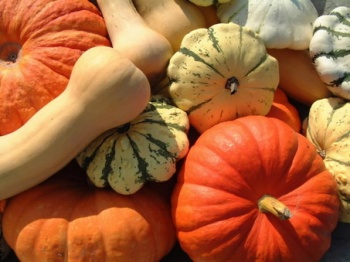Winter Squash
From Wikiwel
Squash is the quintessential fall and winter food. Ironically, we carve pumpkins into all sorts of scary faces, but the truth is, they’re more like big sweet orange smiley faces for your whole body. Aw. While acorn and butternut are the other common winter squash, lesser-known spaghetti, hubbards and turbans are tasty and healthy too.
Contents
Varieties
Winter squash comes in many different flavours, colours, sizes and shapes, but one thing is consistent: the flesh is yellow to deep orange, fibre-rich and sweet, with an inedible skin. Here are the most common varieties:
- Buttercup squash : There are two kinds, each with its unique shape. One looks like a parachute, whereas the other looks more like a crown. It has a thick skin, can be green or orange, and weighs about 1 kg. The flesh is smooth, sweet and dense.
- Hubbard squash : These ones are large, bumpy and oval, ranging from dark greens to vibrant reds to blue. Its flesh is dry, thick, and not very sweet. This large variety weighs in at an impressive 5kg.
- Pumpkin : Pumpkin is a Fall favourite – one that shouldn’t just be used out of the can. Luscious orange and not as meaty as other squashes, the best eating pumpkins are the smaller varieties.
- Butternut squash : One of the most popular varieties, this pear shape variety has a smooth skin and is cream in colour. Its best to eat when about 25cm long and 10cm wide. It also boasts one of the highest beta-carotene amounts, with a sweet and very deep orange flesh.
- Acorn squash : The acorn shaped squash is smooth with thick ridges and dark green with a hint of orange. It’s tastiest when about 12cm in height and 20cm across, and has a delicate, nutty flavour.
- Spaghetti squash : Brighter yellow in colour, spaghetti squash has a mild, nutty flavour that is less starchy than it’s other winter friends. It’s name comes from the texture; once cooked, the flesh separates into spaghetti-like strands.
Special Precautions of Winter Squash
Avoid when you have Cold Sores (Herpes) because it is quite high in Arginine.
Benefits and uses of Winter Squash are
- Anti inflammatory : Prepare your achy joints for winter by boosting up on the anti inflammatory properties found in acorn, butternut and spaghetti squash. It won’t cure your arthritis, but the antioxidants can help alleviate some of the symptoms.
- Vitamin C : A serving of butternut squash has thirty-five percent of the recommended daily value of vitamin C, an essential nutrient that has been shown to significantly reduce the risk of heart attacks. And if you’re filling up on healthy, tasty squash, you decrease the amount of room available in your tummy for accidentally having a Big Mac attack instead.
- preventing birth defects : There are lots of fun things to do indoors during winter besides baking pumpkin pies. If you are pregnant, or planning on becoming pregnant, eating folate rich foods such as that dreamy pumpkin pie can help prevent serious birth defects.
- Winter Skin : The cold air outside mixing with the heat inside causes dry, itchy skin, dandruff and eczema. Bright winter squash colors means they’re loaded with large amounts of beta-carotene, a super skin food. Squash are also a great source of omega 3 fatty acids, which improve skin as well. You can make a great tonifying winter facemask with your pumpkin and squash innards too!
- Cancer can’t grow if it can’t oxidize. That’s why the big deal about antioxidant rich foods is well supported by lots of scientific research. Beta-carotene found in squash is especially important in preventing colon cancer, which is the perfect segue to my favorite subject….
- Fiber is the difference between pumpkin and PumpKing. The creamy texture of pumpkin and other squash may appear to be roughage free, but a ½ cup serving has over 3 grams of fiber! Regular, healthy bowel movements improve your skin, help eliminate toxins and inflammation, and are especially important if that little bump on your belly is not a pumpkin, but a little ‘punkin’ on the way.
